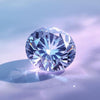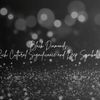
Learn about the History and Facts about Old European Cut Diamonds
Old European Cut Diamonds
Old European cut diamonds hold a special place in the world of gemstones, offering a blend of history, charm, and unique beauty. These antique diamond are precious for their distinctive cut, which capture the essence of a bygone era. In this blog, we'll delve into the history and facts about Old European cut diamonds, exploring their origins, features, and why they continue to captivate jewelry enthusiasts today.
History of the Old European Cut Diamond

Origins: The Old European cut diamond, also known as the European cut or antique European cut, appeared in the late 19th and early 20th centuries This cut was the precursor to the modern brilliant cut and was popular during the Victorian, Edwardian, and Art Deco period.
Evolution: The Old European cut significantly advanced from earlier diamond cuts, such as the Old Mine cut. It introduced more precise fact and better symmetry, enhancing the diamond's brilliance and fire.
Craftsmanship: Jewelry makers from the era cut these diamonds by hand, showcasing their craftsmanship and artistry. Each diamond is unique, with subtle variation that add to its character and charm.
What is an Antique European Cut Diamond?

Definition: An antique European cut diamond is a round diamond with a high crown, small table, and large culet. It feature 58 facet, similar to the modern round brilliant cut, but with a different arrangement that give it a distinct appearance.
Characteristics: The larger facets of the Old European cut create a softer, more romantic sparkle. The high crown and deep pavilion give the diamond a unique profile and vintage appeal.
Distinctive Features: Unlike modern diamond, Old European cut diamond often exhibit a noticeable culet (the small facet at the bottom of the diamond) and a slightly irregular shape, both of which contribute to their antique charm.
Reasons to Favor Old European Cut Diamonds

Unique Beauty: The larger facet and high crown of Old European cut diamond create a unique sparkle that differs from modern diamond. Their softer, more diffused light adds to their romantic appeal.
Historical Significance: Owning an Old European cut diamond is like owning a piece of history.
Sustainability: Choosing an antique diamond is an environmentally friendly option, as it reduces the demand for newly mined diamonds. It's a way to enjoy the beauty of a diamond while being mindful of its environmental impact.
The Anatomy of an Old European Diamond with Trio-Shaped Faceting's
Facet Structure: Old European cut diamond have a unique facet structure that includes trio-shap facets, contributing to their distinctive sparkle. These facets are larger and more pronounc than those of modern diamonds.
High Crown and Deep Pavilion: The high crown and deep pavilion define the key characteristics of the Old European cut. The crown facet angle sharply, creating a dramatic profile and enhancing the diamond light performance.
Large Culet: The Old European cut diamonds feature a large, open culet as a hallmark. This facet, visible through the table, adds to the vintage look and can influence the diamond overall appearance.
The Crown Facets of an Old European Cut Diamond Curve at a 45-50° Angle
Angle of the Crown Facets: The crown facet of Old European cut diamond curve at an angle of 45-50°, which is steeper than those found in modern brilliant cut. This angle enhances the diamond depth and brilliance.
Light Performance: The steep angle of the crown facets allow the diamond to capture and reflect light in a unique way, creating a distinct sparkle that is softer and more romantic than that of modern diamond.
Aesthetic Appeal: The angled crown facets enhance the overall aesthetic of the Old European cut, giving the diamond a timeless and elegant appearance that collectors and enthusiasts eagerly seek.
Old European Cut Diamonds Have Advantages
Distinctive Appearance: The unique facet arrangement and high crown of Old European cut diamond create a distinctive appearance that set them apart from modern diamond. Their vintage charm and historical significance make them highly desirable.
Versatility: You can set these diamonds in a variety of jewelry styles, from vintage-inspired designs to modern settings that highlight their antique beauty.
Investment Value: Due to their rarity and historical significance, Old European cut diamond can be a good investment. Their value often appreciates over time, making them a wise choice for collector and investor.
Old European Cut Diamond Jewelry
Engagement Rings: Old European cut diamonds are a popular choice for engagement rings, offering a romantic and timeless look. They pair beautifully with vintage-inspired settings that highlight their unique features.
Earrings and Necklaces: These diamonds create stunning earrings and necklaces, adding a touch of vintage elegance to any jewelry collection. Their distinctive sparkle and historical charm make them a standout choice for special occasions.
Heirloom Pieces: Old European cut diamond are often use in heirloom jewelry, approved down through generation as cherish family treasures. Their timeless beauty and historical significance make them perfect for creating lasting memories.
Old European Carved Vintage Style Ring
Vintage Style: Old European carved vintage style ring are design to showcase the unique feature of Old European cut diamond. These rings often feature intricate detailing, such as filigree, milgrain, and engraving, that enhances their antique appeal.
Customization: Many jewelers offer customization option for vintage-style ring, allowing you to create a one-of-a-kind piece that reflects your personal style and the unique characteristic of the diamond.
Timeless Elegance: The combination of an Old European cut diamond and a vintage-inspired setting creat a ring that exudes timeless elegance and sophistication. It is a perfect choice for those who appreciate the beauty of the past and the craftsmanship of a bygone era.
Conclusion
Old European cut diamond offer a unique blend of history, beauty, and charm. Their distinctive features, such as the high crown, large culet, and tri-shaped facets, set them apart from modern diamonds and make them a highly desirable choice for those seeking a piece of history. Whether set in engagement rings, earrings, necklaces, or heirloom pieces, these antique diamonds continue to captivate and inspire with their timeless elegance and romantic sparkle.
Frequently Ask Questions (FAQs)
Q1: What is an Old European cut diamond?
An Old European cut diamond is round with a high crown, small table, large culet, and 58 unique facets.
Q2: Why are Old European cut diamond unique?
They are unique due to their hand-cut facet, high crown, and large culet, which give them a distinctive appearance and a softer, more diffused light compar to modern diamond.
Q3: What are the benefit of Old European cut diamond?
Advantages include their unique beauty, historical significance, sustainability, and potential investment value.
Q4: How do Old European cut diamond differ from modern brilliant cut diamond?
Old European cut diamond have larger facet, a higher crown, a smaller table, and a larger culet, creating a different light performance and aesthetic compar to modern brilliant cut diamond.
Q5: Can Old European cut diamond be used in modern jewelry setting?
Yes, you can set Old European cut diamonds in both vintage-inspired and modern settings, allowing for a variety of design options.
Q6: What makes Old European cut diamonds valuable?
Their rarity, historical significance, unique beauty, and hand-cut craftsmanship contribute to their value, making them highly sought after by collector and enthusiasts.
Q7: Are Old European cut diamond a good investment?
Yes, due to their rarity and historical significance, can appreciate in value over time, making them wise investment choice.
Old European cut diamonds have larger facets, a higher crown, smaller table, and larger culet, creating a unique light performance.
TABLE OF CONTENTS
- History of the Old European Cut Diamond
- What is an Antique European Cut Diamond?
- Reasons to Favor Old European Cut Diamonds
- The Anatomy of an Old European Diamond with Trio-Shaped Faceting's
- The Crown Facets of an Old European Cut Diamond Curve at a 45-50° Angle
- Old European Cut Diamonds Have Advantages
- Old European Cut Diamond Jewelry
- Old European Carved Vintage Style Ring
- Conclusion
- Frequently Asked Questions (FAQs)
Leave a comment
Please note, comments must be approved before they are published.









